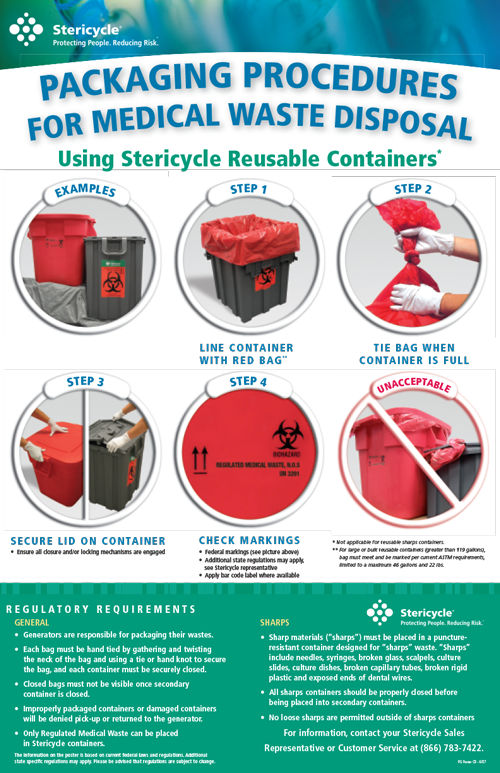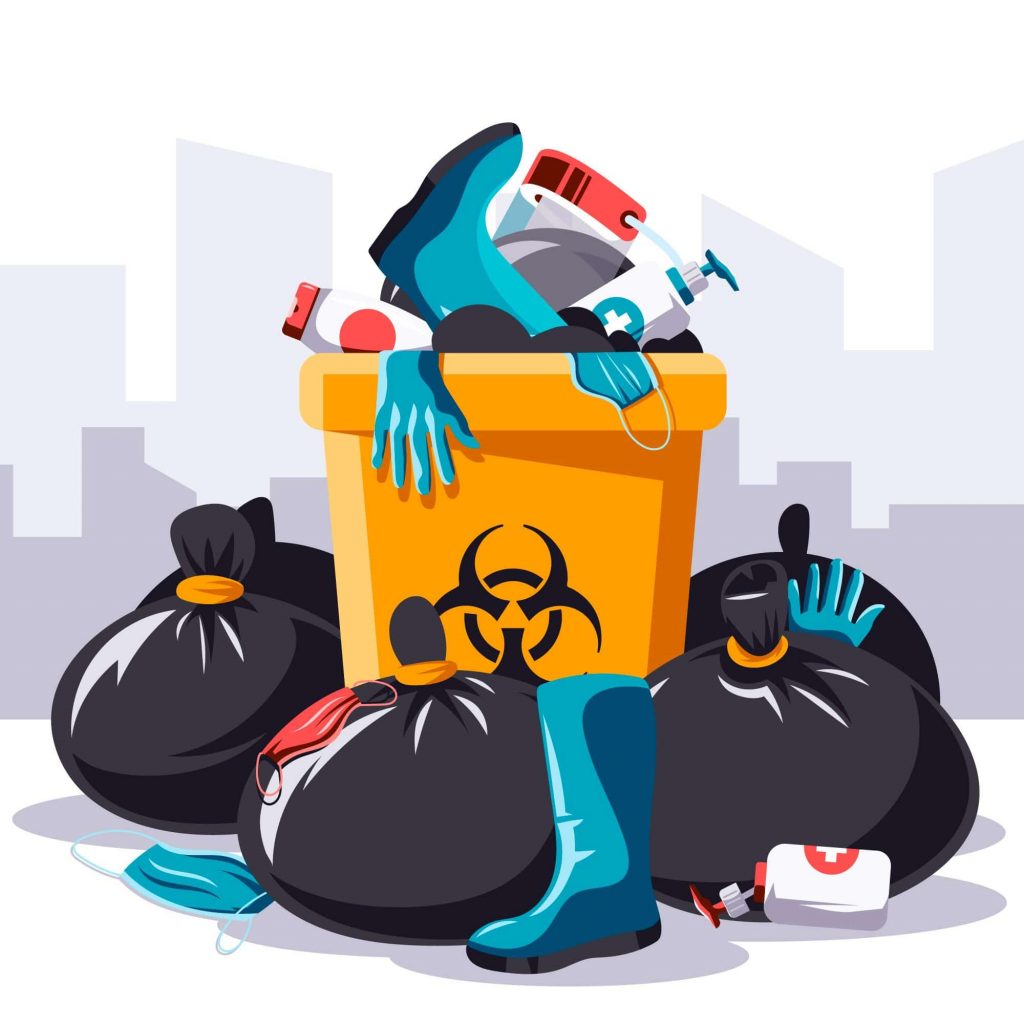Strategic Medical Waste Disposal Solutions: Promoting Safety and Sustainability
Wiki Article
Conformity and Laws for Medical Waste Disposal
Compliance and laws for medical waste disposal play an essential role in making sure the security and wellness of both medical care specialists and the basic public. Proper management of medical waste is vital to stop the spread of infections, protect the environment, and maintain public health and wellness. These guidelines incorporate numerous aspects, including the classification and segregation of medical waste, proper storage and dealing with procedures, as well as transportation and disposal methods.Significance of Conformity
The value of conformity with guidelines for clinical garbage disposal can not be overemphasized. Correct disposal of clinical waste is crucial for making sure the safety and security and well-being of health care workers, individuals, and the public. Clinical waste, which consists of things such as used needles, contaminated gloves, and biomedical waste, can posture severe health and wellness threats otherwise handled and dealt with effectively.Conformity with regulations makes sure that clinical waste is managed in such a way that minimizes the potential for exposure to damaging compounds and infectious diseases - medical waste disposal service. It aids stop the spread of infections, such as HIV, hepatitis B and C, and other bloodborne microorganisms. Compliance also plays a vital duty in shielding the setting by stopping contamination of water resources, soil, and air
Failure to follow regulations can cause extreme repercussions for health care facilities, consisting of penalties, lawsuit, and damage to their credibility. Additionally, non-compliance might jeopardize the health and wellness of healthcare employees, individuals, and the community.
Conformity with policies for clinical waste disposal requires adherence to specific standards and methods. These may consist of correct segregation, packaging, labeling, and storage space of medical waste. It likewise includes making use of accepted disposal methods, such as autoclaving, landfilling, or incineration, relying on the sort of waste.
Governing Agencies and Bodies
Regulatory companies and bodies play an essential function in supervising conformity with guidelines for medical waste disposal. These organizations are in charge of setting standards, requirements, and methods to ensure the appropriate and safe handling of medical waste. They apply and check compliance to safeguard public wellness and the atmosphere.Among the most noticeable governing companies in the USA is the Epa (EPA) The EPA is accountable for controling the storage, transportation, treatment, and disposal of clinical waste. They establish guidelines for waste generators, carriers, and therapy facilities to follow, guaranteeing that all necessary safety measures are required to protect against the spread of illness and contamination.
Another important governing body is the Occupational Safety and Health And Wellness Administration (OSHA) OSHA sets standards and regulations to safeguard employees from job-related dangers, including those related to clinical waste. WasteX Medical Waste Disposal. They offer standards for the risk-free handling and disposal of clinical waste to safeguard staff members in health care centers
Along with these government agencies, specific states also have their very own regulatory bodies that oversee clinical waste disposal. These agencies might have their own certain guidelines and requirements that have to be complied with.

Classification and Partition of Medical Waste
To ensure correct administration of medical waste, it is necessary to identify and segregate it according to developed guidelines and methods. medical waste disposal. Classification and segregation play a critical role in lessening the threat of infection, safeguarding the atmosphere, and making certain the safety of health care employees and the publicMedical waste is classified into various categories based on its prospective hazard degree. These categories consist of contagious waste, pathological waste, sharps waste, pharmaceutical waste, chemical waste, and contaminated waste. Each classification requires certain handling, storage space, transport, and disposal techniques to minimize the risk of direct exposure and contamination.
Partition of clinical waste includes separating different sorts of waste at the source. This process guarantees that waste with different risk levels is not mixed, WasteX Medical Waste Disposal reducing the potential for cross-contamination and making disposal procedures extra reliable. Proper partition is accomplished via using color-coded tags and containers, which aid medical care workers and waste monitoring employees handle each kind and identify of waste appropriately.
In addition to category and segregation, medical care facilities need to also adhere to local, state, and federal regulations relating to medical waste management. These guidelines describe certain demands for storage space, transportation, therapy, and last disposal of medical waste, making certain conformity and maintaining public wellness and security.
Proper Storage Space and Managing Procedures
Proper storage space and taking care of treatments play an essential duty in making certain the certified and secure monitoring of medical waste. Clinical waste, that includes items such as used syringes, contaminated gloves, and expired medications, can posture severe health and environmental risks if not managed appropriately. It is crucial for healthcare centers and various other generators of medical waste to execute stringent storage and dealing with protocols.
To start with, clinical waste must be kept in long lasting, leak-proof containers that are specifically designed for this function. These containers ought to be labeled with the global biohazard sign and the words "clinical waste" to clearly indicate the components. Additionally, the containers should be kept securely near to protect against any possible leakage or splilling.
Additionally, it is necessary to segregate different kinds of clinical waste to avoid cross-contamination. Sharps, such as needles and scalpels, need to be stored in puncture-resistant containers to reduce the threat of injuries - WasteX Medical Waste Disposal. Chemical waste, such as solvents and disinfectants, must be kept independently from other sorts of clinical waste to stop chemical responses or hazardous exposures

Transport and Disposal Techniques
Healthcare facilities have to make sure the risk-free transportation and appropriate disposal of their clinical waste to conform with guidelines and shield public health and wellness. Transportation and disposal approaches play an essential duty in avoiding the spread of transmittable illness and lessening the environmental effect of medical waste.
To move medical waste, healthcare centers should use leak-proof and puncture-resistant containers that are labeled with the biohazard symbol. These containers should be securely secured to stop any leakage during transportation. Furthermore, medical care centers should develop protocols for the transport procedure, including the usage of devoted lorries and skilled employees.
Once the medical waste gets to the disposal center, it undergoes numerous methods of treatment. One typical approach is incineration, which involves shedding the waste at high temperature levels to destroy microorganisms and lower the volume of waste. One more approach is autoclaving, which uses heavy steam and stress to sanitize the waste. After therapy, the waste is generally sent out to a landfill or a waste-to-energy center for last disposal.
It is crucial for medical care centers to function with qualified and allowed waste monitoring firms to make sure correct transport and disposal of medical waste. These business have the experience and resources to deal with medical waste safely and in conformity with laws.
Verdict
In final thought, conformity with guidelines for medical waste disposal is of utmost value to guarantee public wellness and safety. On the whole, adherence to compliance and laws is needed to efficiently take care of medical waste.Clinical waste, which consists of products such as made use of needles, polluted handwear covers, and biomedical waste, can position significant health and wellness threats if not managed and disposed of properly.
These classifications include contagious waste, pathological waste, sharps waste, pharmaceutical waste, chemical waste, and radioactive waste.Segregation of medical waste entails separating various types of waste at the resource. Proper segregation is attained through the usage of color-coded containers and labels, which aid medical care workers and waste management workers determine and handle each kind of waste correctly.
Chemical waste, such as disinfectants and solvents, must be stored independently from various other types of clinical waste to avoid hazardous direct exposures or chemical responses.
Report this wiki page